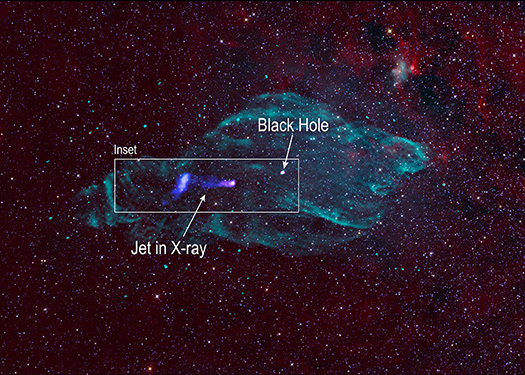This composite image of the Manatee Nebula captures the jet emanating from SS 433, a black hole pulling material inwards that is embedded in the supernova remnant which spawned it. Radio emission from the supernova remnant are blue-green, whereas the X-ray from IXPE, XMM-Newton and Chandra are highlighted in bright blue-purple and pink-white set against a backdrop of infrared data in red. The black hole emits twin jets of matter traveling in opposite directions at nearly the speed of light.
These jets distort the remnant’s shape into one astronomers dubbed the Manatee. The jets become bright about 100 light-years away from the black hole, where particles are accelerated to very high energies by shocks within the jet. The IXPE data shows that the magnetic field, which plays a key role in how particles are accelerated, is aligned parallel to the jet — aiding our understanding of how astrophysical jets accelerate these particles to high energies.

A new paper, detailing IXPE’s observations at SS 433, is available in the latest edition of The Astrophysical Journal. IXPE is a collaboration between NASA and the Italian Space Agency with partners and science collaborators in 12 countries. IXPE is led by NASA’s Marshall Space Flight Center. Ball Aerospace, headquartered in Broomfield, Colorado, manages spacecraft operations together with the University of Colorado’s Laboratory for Atmospheric and Space Physics in Boulder.
NASA's Marshall Space Flight Center manages the Chandra program. The Smithsonian Astrophysical Observatory's Chandra X-ray Center controls science operations from Cambridge, Massachusetts, and flight operations from Burlington, Massachusetts.
This composite image shows SS 433, a black hole embedded in a supernova remnant. The shape of the supernova remnant resembles the shape of a marine mammal known as the manatee, earning the remnant the nickname, the Manatee Nebula.
The manatee-like structure is oriented with its head toward the right side of the image, and its paddle-shaped tail toward the left side of the image, appearing as a somewhat transparent cloud of bluish-green. In the middle of the remnant is a bright white dot. This dot is black hole SS 433.
Farther toward our left, just above what would be the animal's tail, is an area mostly devoid of material. Here, jets of matter detected in X-ray light are purple-blue, with the black hole detected in X-ray light in pink. The jets are traveling in the opposite direction from the black hole at extreme speeds, causing distortion in the shape of the remnant.
The background of the image features a multitude of white flecks and wispy red streaks, stars and material glowing in infrared light.
|
||||||||||||||||||||||||||||||

| Share This |
|

